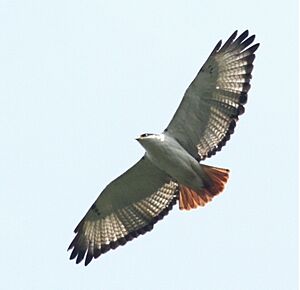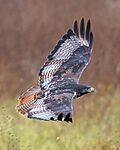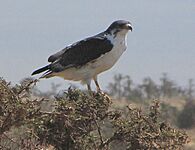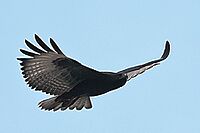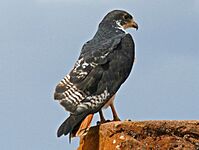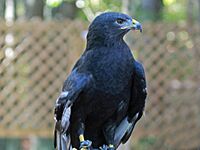Augur buzzard facts for kids
Quick facts for kids Augur buzzard |
|
|---|---|
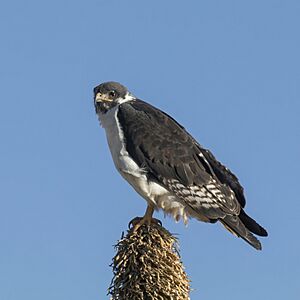 |
|
| Ethiopia | |
| Conservation status | |
| Scientific classification | |
| Genus: |
Buteo
|
| Species: |
augur
|
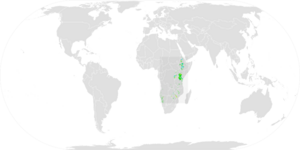 |
|
| Global map of eBird reports Year-Round Range Summer Range Winter Range | |
The augur buzzard (Buteo augur) is a large bird of prey found in Africa. It's known for its striking looks. Adult birds usually have a dark back, a white belly, and a bright orange-red tail. Young augur buzzards are mostly brown.
Some augur buzzards have a special "dark morph." This means their whole body is much darker, almost black. These birds live in central and southern Africa. You can find them from Ethiopia all the way to southern Angola and central Namibia. They stay in these areas all year round and do not migrate. Augur buzzards often live in mountains, usually around 2,000 meters (about 6,500 feet) high. They can even be found up to 5,000 meters (about 16,400 feet). They also live in nearby grasslands and savannas. Like many buzzards, they are generalist hunters. This means they eat many different things. Their favorite foods are small mammals, but they also eat reptiles and other birds.
Contents
About the Augur Buzzard
What is a Buzzard?
Buzzards are a type of bird of prey. They belong to the Buteo genus. This group includes many medium-sized raptors. They are known for their broad wings and strong bodies. Buzzards are often seen soaring high in the sky. They use their excellent eyesight to spot prey on the ground.
How Scientists Classify Them
Scientists are still learning about how the augur buzzard is related to other birds. Some think it's part of a "superspecies" with the jackal buzzard and Archer's buzzard. A superspecies is a group of very similar species. They might have once been the same species.
Each of these buzzards looks a bit different. They also have unique calls. The Archer's buzzard is sometimes thought to be a subspecies of the augur buzzard. A subspecies is a group within a species. It has small differences from other groups.
Currently, two main types (subspecies) of augur buzzards are recognized:
- B. a. augur (Rüppell, 1836) - Found from Ethiopia south to Zimbabwe, and from Angola south to central Namibia.
- B. a. archeri (Sclater, WL, 1918) - Also known as Archer's buzzard. It lives in the mountains of northern Somalia.
What Does an Augur Buzzard Look Like?
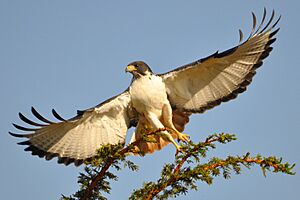
Augur buzzards are one of the largest Buteo species in Africa. They are similar in size to their relatives, the jackal buzzards. Adult birds are about 48 to 60 centimeters (19 to 24 inches) long. Their wingspan can be very wide, from 120 to 150 centimeters (4 to 5 feet).
Female augur buzzards are usually a bit larger than males. Males weigh about 880 to 1,160 grams (1.9 to 2.6 pounds). Females weigh about 1,100 to 1,330 grams (2.4 to 2.9 pounds).
Adult Augur Buzzards
Adult augur buzzards are easy to spot. Their upper body is almost black-brown. Their tail is a bright rufous (reddish-brown) color, which stands out a lot. Their main flight feathers are blackish. The feathers closer to their body are off-white with black stripes.
Below their chin and around their throat is mostly white. The rest of their underside and the feathers under their wings are a rich rufous color. When they fly, the feathers under their wings look white. They have black tips, which create a dark edge on the back of their wings.
Young Augur Buzzards
Young augur buzzards are mostly brown on top. Their underside and tail are a reddish-brown. They can sometimes be confused with other buzzards. However, young augur buzzards are much bigger and stronger. They have wider wings and fly in a heavier way. Their tail also doesn't have stripes.
Dark-Morph Augur Buzzards
About 10% of augur buzzards are "melanistic." This means they are almost completely black. Only their flight feathers are grey and white with black stripes. These feathers stand out against their black body. In some rainy, forested areas, up to 50% of the birds can be dark-morph.
It can be hard to tell a dark-morph augur buzzard from a dark-morph jackal buzzard. However, the augur buzzard usually has stronger stripes on its pale flight feathers.
Where Do Augur Buzzards Live?
Augur buzzards live in eastern and southwestern Africa. Even though their homes seem spread out, they are often common in these areas. You can find them from eastern Sudan and Ethiopia (including northern Somalia) down through parts of the Democratic Republic of the Congo, Uganda, Kenya, and Tanzania. They also live in Zambia, Malawi, Zimbabwe, Mozambique, western Angola, and west-central Namibia. They are rarely seen in South Africa.
Their Favorite Places to Live
Augur buzzards like open areas or lightly wooded upland regions. But they can also live in lowland deserts, like in Namibia. Some live in very mountainous areas of eastern Africa. They prefer to hunt in high savanna grasslands and moorland. They can also be found in farmland, open forests, or on the edges of deserts.
In east Africa, augur buzzards usually live between 400 and 4,600 meters (about 1,300 to 15,000 feet) high. They are most often found above 1,500 meters (about 4,900 feet). In Ethiopia, they have been seen living as high as 5,000 meters (about 16,400 feet).
Augur Buzzard Behavior
Calls and Mating
Augur buzzard pairs often perform noisy aerial displays. They do this even when it's not breeding season. Their call is very different from other birds of prey. It sounds like a harsh, loud crow: a-kow a-kow a-kow or a-ung a-ung a-ung. When they are flying high, their call becomes longer and higher-pitched: a-waaa a-waaa a-waaa.
Augur buzzard pairs usually stay together for their whole lives. However, sometimes a male might mate with more than one female.
Nests and Chicks
They build large nests out of sticks. These nests can be up to 1 meter (about 3 feet) wide. They build them in trees or on cliffs. They often reuse and make their nests bigger each year.
Females usually lay two eggs, but sometimes only one or rarely three. The eggs are creamy or bluish-white. Only the female sits on the eggs to keep them warm. The male brings her food while she is on the nest. The eggs hatch in about 40 days. The chicks are ready to try flying after another 56 to 60 days. They become independent from the nest around 70 days old. Young birds might stay with their parents for some time after that.
What Do They Eat?
Augur buzzards eat a wide variety of foods. This is common for most Buteo species. They catch most of their prey on the ground. They either hunt from a perch, or they swoop down from high in the sky. Sometimes, they even hover in the air before diving. They might also walk on the ground to find insects and small vertebrates.
Their main foods are small mammals that live on the ground. They also eat reptiles, especially snakes and lizards. Other foods include small ground birds (including chicks), insects, and animals killed on roads.
In Zimbabwe, reptiles made up 59% of their diet. The rest was mostly mammals, like vlei rats. At one nest, lizards were 35% of the food, and snakes were 46%. In Tanzania, their stomachs mostly contained different kinds of rats and lizards. They can even hunt dangerous prey like Nile monitors (though not large adults) and venomous snakes like puff adders. Sometimes, they hunt larger animals like francolins, domestic chickens, hares, and hyraxes. However, they usually target the young of these larger animals.
Gallery
-
Augur buzzard in flight with top feathers view, Ngorongoro Conservation Area
-
Lake Manyara, Tanzania
-
in flight near Kisoro, Uganda



